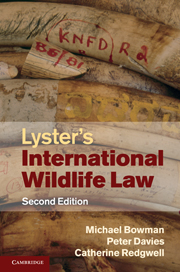Book contents
- Frontmatter
- Contents
- Foreword
- Preface
- List of abbreviations
- PART I Foundations of international wildlife law
- PART II Species regulation
- PART III Regional wildlife regulation
- PART IV Global wildlife regulation
- 13 The Ramsar Convention on Wetlands
- 14 The World Heritage Convention
- 15 The Convention on International Trade in Endangered Species of Wild Fauna and Flora
- 16 The Convention on the Conservation of Migratory Species
- PART V Biological diversity: a new perspective on wildlife regulation
- PART VI Cross-sectoral issues in wildlife regulation
- PART VII Conclusion
- Index
- References
14 - The World Heritage Convention
Published online by Cambridge University Press: 05 July 2011
- Frontmatter
- Contents
- Foreword
- Preface
- List of abbreviations
- PART I Foundations of international wildlife law
- PART II Species regulation
- PART III Regional wildlife regulation
- PART IV Global wildlife regulation
- 13 The Ramsar Convention on Wetlands
- 14 The World Heritage Convention
- 15 The Convention on International Trade in Endangered Species of Wild Fauna and Flora
- 16 The Convention on the Conservation of Migratory Species
- PART V Biological diversity: a new perspective on wildlife regulation
- PART VI Cross-sectoral issues in wildlife regulation
- PART VII Conclusion
- Index
- References
Summary
Background
The UNESCO Convention Concerning the Protection of the World Cultural and Natural Heritage (WHC) was adopted on 16 November 1972 and came into force on 17 December 1975. Its origins can be traced to three separate but related factors. The first is that by 1972 the international community was becoming increasingly receptive to the concept of a ‘common heritage’. In the context of the Convention, this is reflected in the idea that there are certain outstanding natural or man-made features, such as the Serengeti or the Pyramids, the Galapagos Islands or the Taj Mahal, which should be seen as the heritage of more than just one state. They constitute part of the heritage of all people, and humankind as a whole accordingly has certain rights and duties with respect to their conservation. In this respect, the Convention tapped into the emergence in the 1960s and 1970s of the concept of the common heritage of mankind, which was to feature prominently in the negotiation of the 1982 Law of the Sea Convention. It also reflects the concepts of ‘universal heritage’ and ‘the common heritage of humanity’ found in other UNESCO instruments. In the particular context of wildlife protection, the Convention has maintained this distinctive perspective in protecting the natural heritage both within UNESCO and, more widely, as part of a web of biodiversity-related treaties under the umbrella of the 1992 CBD.
- Type
- Chapter
- Information
- Lyster's International Wildlife Law , pp. 451 - 482Publisher: Cambridge University PressPrint publication year: 2010



